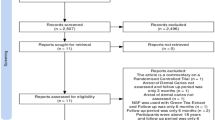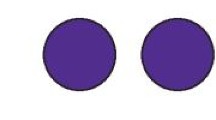Abstract
Data Sources
Data, from reports written in English, Spanish, or Portuguese, were identified using searches in Medline, LILACS (Latin American and Caribbean Health Sciences Literature), Embase, the Cochrane Library, and the Brazilian Dental Library databases.
Study selection
Human randomised controlled trials (RCT), or cohort or case–control studies, where patients not teeth were the unit of assessment, were included. Studies were excluded if they were early reports of longer studies, in vitro or animal studies, narrative reviews or editorials, or were published in languages other than English, Spanish or Portuguese. Studies were assessed independently by two investigators with disputes being resolved by a third. Quality was assessed using the Jadad scale.
Data extraction and synthesis
Data were extracted independently by two investigators. The prevented fraction (PF) and number-needed-to-treat (NNT) were calculated.
Results
Two studies met the inclusion criteria. They indicated that the silver diamine fluoride (SDF) lowest PF for caries arrest and caries prevention were 96.1% and 70.3%, respectively; NNT were 0.8 (95% confidence interval, 0.5–1.0) and 0.9 (95% confidence interval, 0.4–1.1), respectively. Adverse events were monitored, with no significant differences being found between control and experimental groups.
Conclusions
These promising results suggest that SDF is more effective than fluoride varnish, and may be a valuable caries-preventive intervention.
Similar content being viewed by others
Commentary
This paper presents the results of a systematic review examining the evidence available to support the use of 38% SDF to prevent or arrest caries. The paper starts by outlining the many current and historical uses of silver and silver compounds in medicine and dentistry, which stretch back as far as 1000 BC and of course includes amalgam restorations.
SDF is postulated to prevent or arrest caries by three mechanisms. The first of these is through the action of fluoride, the second via the reaction of silver with bacterial amino acids and nucleic acids, which prevents bacterial metabolism and is thus bactericidal, the third by precipitation of a layer of insoluble silver apatite. The application of SDF appears almost as simple as the application of fluoride varnish, as it can be painted on and left for 3 min per quadrant.
The systematic review methods used here appear sound but, unfortunately, only two RCT were identified that could be included in the review. Chu et al. (2002)1 compared an annual application of SDF with 3-monthly applications of 5% sodium fluoride (NaF) varnish to carious upper anterior teeth of 3–5-year old children in China. There was a further control group where water was applied. They also investigated whether excavating the caries before application of the SDF or NaF varnish had any effect. The second RCT, by Llodra et al. (2005),2 compared a twice-yearly application of SDF to carious primary canines, molars and first molars of children in Cuba, with the application of water as the control. Both studies found SDF to be effective at preventing the development of new carious lesions and arresting existing ones and, compared with fluoride varnish, was more effective. Caries excavation had no effect on the findings.
These results are very promising but, as ever, further studies are required to confirm the results on other samples. For example, the participants in the study by Llodra and colleagues (2005)2 had little access to fluoride toothpaste, whereas the better use of fluoride toothpaste in the study by Chu et al. (2002)1 was still less then ideal. There has been one further RCT published this year which presumably would be included in any future revisions of this review, which again demonstrates SDF effectively arresting caries in primary teeth.3 Few side-effects were reported but, again, this requires further investigation as some adverse effects, such as gingival sensitivity and dark staining, are potential issues when SDF is used.
Although I cannot, on this evidence, agree that SDF is a “silver bullet”, it certainly appears to have great potential both to prevent and arrest caries and we should all consider its use.
References
Chu CH, Lo ECM Lin HC . Effectiveness of silver diamine fluoride and sodium fluoride varnish in arresting dentin caries in Chinese pre-school children. J Dent Res 2002; 81: 767–770.
Llodra JC, Rodriguez A, Ferrer B, et al. Efficacy of silver diamine fluoride for caries reduction in primary teeth and first permanent molars of school children: 36-month clinical trial. J Dent Res 2005; 84: 721–724.
Yee R, Holmgren C, Mulder J, Lama D, Walker D, van Palenstein Helderman W . Efficacy of silver diamine fluoride for arresting caries treatment. J Dent Res 2009; 88: 644–647.
Author information
Authors and Affiliations
Additional information
Address for correspondence: A. Rosenblatt, Forsyth Institute, 140 The Fenway, Boston MA 02115, USA. E-mail: arosenblatt@forsyth.org
Rosenblatt A, Stamford TC, Niederman R. Silver diamine fluoride: a caries “silver-fluoride bullet”. J Dent Res 2009; 88: 116–125
Rights and permissions
About this article
Cite this article
Deery, C. Silver lining for caries cloud?. Evid Based Dent 10, 68 (2009). https://doi.org/10.1038/sj.ebd.6400661
Published:
Issue Date:
DOI: https://doi.org/10.1038/sj.ebd.6400661
This article is cited by
-
Caries arrest effectiveness of silver diamine fluoride compared to alternative restorative technique: randomized clinical trial
European Archives of Paediatric Dentistry (2021)



